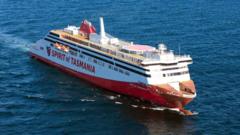A massive ferry from Australia, the Spirit of Tasmania IV, is set to be mothballed in Edinburgh, resulting from a significant "ferries fiasco" that has generated considerable political turmoil. The 212-meter-long vessel, constructed at a Finnish shipyard, faces relocation to the Port of Leith due to its incompatibility with current berthing facilities in the Australian city of Devonport. The ferry, designed to bolster Tasmania's tourism, must leave the Finnish port before winter to avert damage from incoming pack ice, as revealed by TT-Line chief executive Bernard Dwyer.
With local infrastructure upgrades lagging behind schedule, a new terminal in Tasmania to accommodate the massive ship will not be completed until late 2026 or 2027. The delays have escalated into what Australian media describe as a scandal of unprecedented scale, with criticism aimed at the operational capabilities of state-owned entities TT-Line and TasPorts. The resignation of key figures, including infrastructure minister Michael Ferguson and TT-Line chairman Mike Grainger, underscores the severity of the situation.
Dwyer emphasized the urgent need to safeguard the ferry's condition given the extreme temperatures anticipated in Rauma, Finland. While the company is exploring potential leasing options, it faces further complications due to the technical requirements mandated by the initial construction deal, which includes finishing touches expected to be conducted upon the ferry's arrival in Australia.
The predicament of the Spirit of Tasmania IV has drawn parallels to Scotland's own battles with oversized state-owned ferries. Issues regarding the Glen Sannox and Glen Rosa vessels, being constructed at Ferguson shipyard, echo Tasmania's experience with berthing challenges and construction delays that have already impacted ferry scheduling and operations, illustrating broader systemic faults in ferry infrastructure management and planning.




















